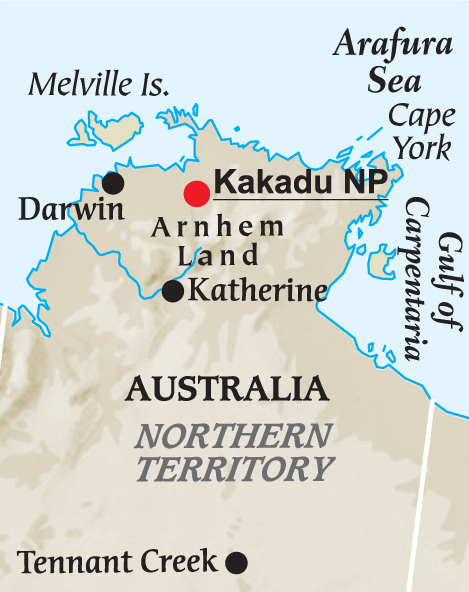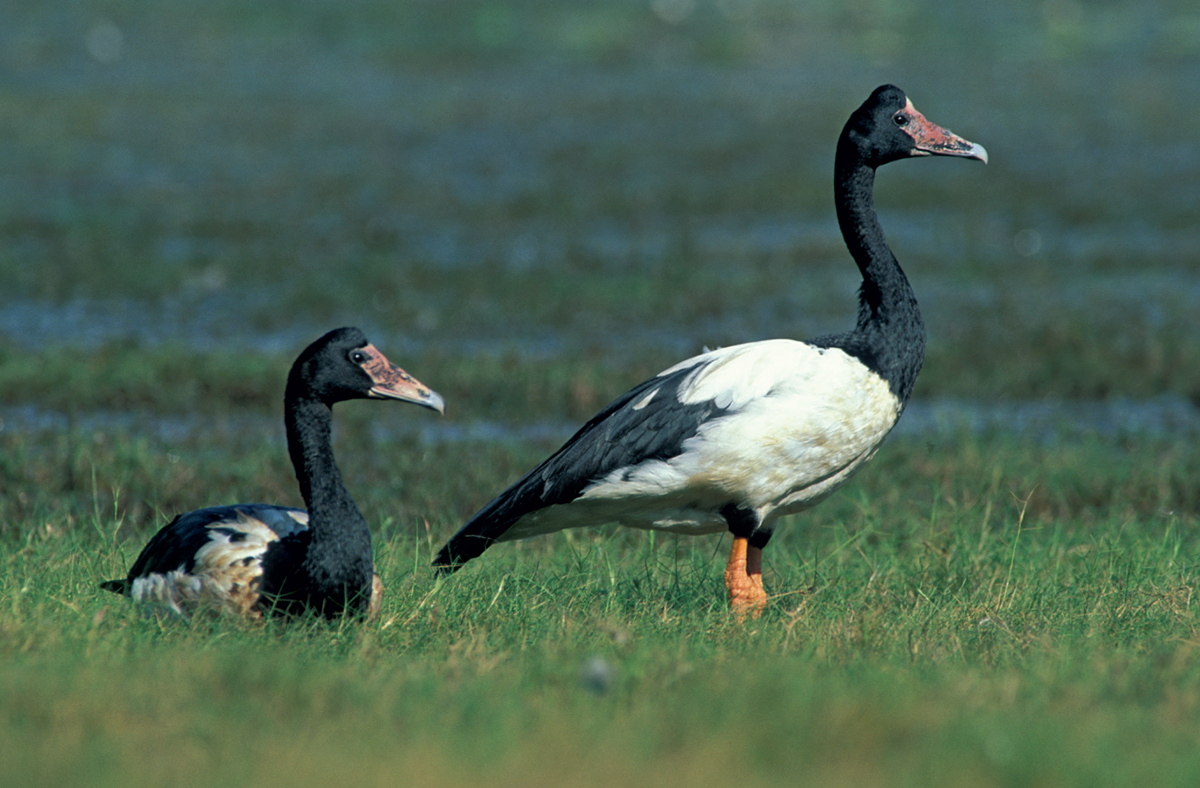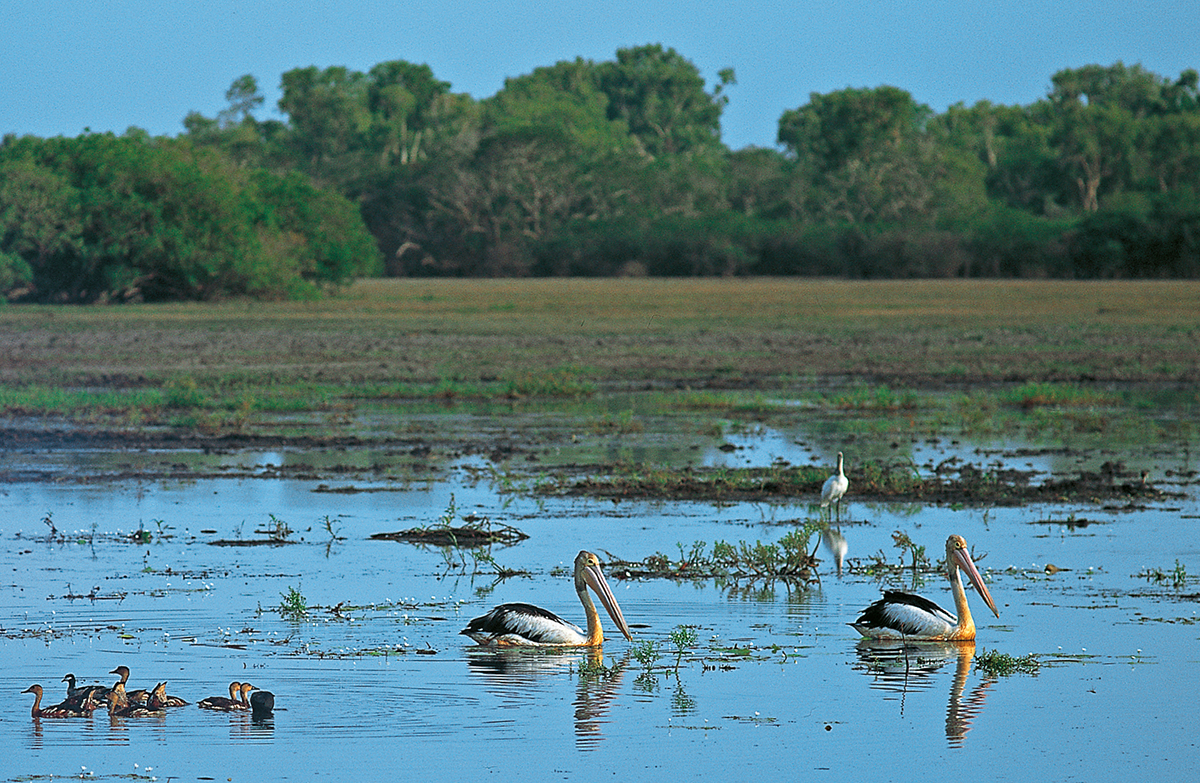
Australia
Kakadu

Information
SITE RANK
33
HABITAT Tropical savanna, floodplain wetland, sandstone cliff and patches of rainforest
KEY SPECIES Magpie Goose, Brolga, Partridge Pigeon, Chestnut-quilled Rock Pigeon, Banded Fruit Dove, White-throated Grasswren, Sandstone Shrikethrush
TIME OF YEAR All year, but best between April and October (dry season)

With a population numbering in the hundreds of thousands, Kakadu is the world’s most important site for the peculiar Magpie Goose.
Situated in the ‘top end’ of the Northern Territory, Kakadu is the largest national park in Australia, encompassing 20,000 sq km of prime wilderness with high biological and cultural significance. It is partly owned by the Aboriginal peoples’ Gagudju Association and is particularly famed for its fabulous rock art sites, such as Ubirr Rock and Nourlangie. These include depictions of prehistoric megafauna, such as the Marsupial Tapir, indicating that the area has been occupied by humans for at least 60,000 years. Impressive though this is, the adjacent escarpment of Arnhem Land, a 500-km-long sandstone plateau that dominates the skyline of the floodplain beneath, is thought to date back two billion years. It was there when all the continents were joined together, and before life emerged from the sea. At times in Kakadu, the feeling of antiquity is almost tangible.
These days the national park consists of four main habitats: the sandstone cliffs and outcrops, the floodplain of the South and East Alligator Rivers, the vast area of tropical savanna, and much smaller patches of rainforest. All have their typical birds, making this national park an exceptional place for the birder. About 300 species have been recorded in all.
The sandstone areas hold two birds that are endemic to the Arnhem Land area, and that will be high on the wish-list of any visiting birder. The best place to see them is probably Gunlom Falls, towards the south-west corner of the park. The handsome White-throated Grasswren, the largest of its charismatic group (see also the Strzelecki Track account), is quite easy to find here, especially in the very early morning. A chocolate-brown species, with white streaks on its upperparts and a brilliant white throat and upper breast, it is found in bare rocky areas with some spinifex growth. Like other grasswrens it is reluctant to fly, instead running with head and long tail lowered from bush to bush or into a crevice, never to emerge again. By contrast, in the rocky cliffs it is easy to catch up with Chestnut-quilled Rock Pigeon, a large pigeon whose dull brown appearance is transformed when it takes flight and shows its bright chestnut primaries. These birds usually occur in groups and fly off with loud wing-beats; they feed among rocks on the ground. Two other specialities of the area include the Sandstone Shrikethrush, a thrush-sized bird with a melodious song, whose plumage matches its habitat, and the black-and-white Banded Fruit Dove, here at its only Australian outpost. It occurs in patches of rainforest in the sandstone gorges and ridges, feeding mainly on the fruits of sandstone fig.
The rivers in Kakadu National Park may be named after alligators, but it is crocodiles that occur here, in large numbers. Most of these are the extremely dangerous Estuarine Crocodiles, known locally as ‘salties’; they make birding in wetland areas a potentially hazardous business. Fortunately, you can see the birds while remaining safe by going on a cruise by the permanent billabong known as Yellow Water, in the centre of the park. Book early and take the earliest departure of the day, and you could well be treated to a couple of hours’ birding ecstasy. The Comb-crested Jacana is easy to see on the abundant water-lily pads, often in company with the Green Pygmy Goose, one of the world’s smallest wildfowl species. Herons are represented by such species as Rufous Night Heron and by enormous numbers of Intermediate Egrets (up to 90,000 in the park). The Brolga, an Australian member of the crane family, forages for the tubers of sedges, while the Black-necked Stork, almost as tall, wades in shallows in search of fish. On vegetation around the billabong perch two small kingfishers, the Azure Kingfisher, with orange breast, and the Little Kingfisher, deep blue with a white breast. The Little usually perches lower than the more common Azure, and takes smaller fish.
Another species you can hardly fail to see in the wetlands is the Magpie Goose, for which Kakadu is the most important site in the world; an average of 1.6 million of these birds spends the dry season in the park. This peculiar long-necked, long-legged waterfowl has only partially webbed feet, spending much of its time on land digging for tubers and bulbs, its main food items. These are large birds, and their bold black-and-white plumage makes them stand out easily; they make loud, resonant honking noises, aided by an extraordinary elongated trachea. When breeding, they usually occur in trios, one male with two females laying eggs into the same nest.
Kakadu is a place of extreme seasons; the local Aborigines actually recognize six of them, giving each a different name. The dry season begins in April and lasts until October; as time passes the floodplain gradually dries out until much of the wetland area is caked mud. The high tourist season coincides with the austral winter in July and August, when it is easy to get about and many of the water birds are concentrated into spectacular gatherings. There is then the ‘build-up’ season, when it becomes increasingly humid and thunderstorms bring the first rains. Kakadu has more thunderstorms than anywhere else on earth, with 80 lightning strikes a day at peak times, and these continue into the true wet season from January to March. The monsoon rains can make roads in the park impassable.
The best flowering season happens at the end of the wet, when the first water-lilies adorn the rich waterways of the rivers and billabongs. In the sandstone country and in the savanna, the eucalyptus and grevillea bloom. The latter is a particular delicacy for honeyeaters, especially Little and Silver-crowned Friarbirds, two grey-brown species that often occur together, albeit with much competitive tension. Two colourful lorikeets also feed on the plenty, the rather local Varied Lorikeet and the local race of Rainbow Lorikeet, which is known as Red-collared Lorikeet. Flowers are available in the park for quite a few months, with these and other birds following the blooming of different plants in nomadic style. Fortunately, in the vast area of this magnificent national park, they have plenty of space in which to move.

As floodwaters recede, waterbirds become more concentrated and easier to see. Australian Pelican, Royal Spoonbill, Green Pygmy Goose and Plumed Whistling-Duck are on show here.

The Black-necked Stork, known locally as the ‘jabiru’ (which is not to be confused with the South American stork species of the same name), often chases after fish with rapid steps and wings outspread, although these two are looking more leisurely.